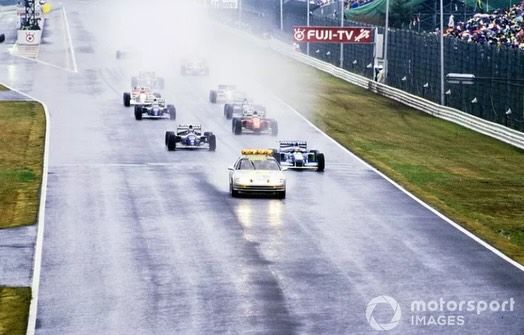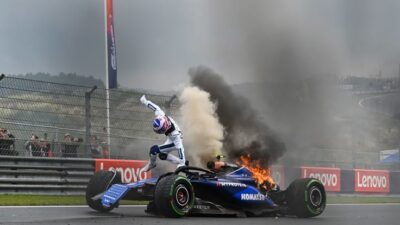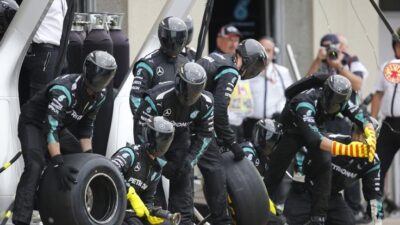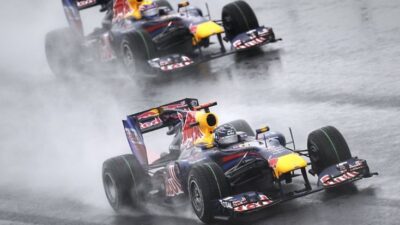Racing fans know the heart-pounding moment when yellow flags wave and a special vehicle appears on track to control the field. Safety cars serve as critical guardians in motorsport, slowing down racing vehicles during dangerous conditions like crashes, debris on track, or severe weather to protect drivers, marshals, and spectators. These high-performance vehicles have evolved from simple pace cars into sophisticated safety systems that can instantly transform race dynamics.
The safety car was first introduced to Formula 1 in 1973 during the Canadian Grand Prix, though the early deployment led to confusion about race positions. Modern safety car operations have become much more refined, with trained professional drivers like Bernd Mayländer who has been F1’s primary safety car driver since 2000.
Beyond their primary safety function, safety cars create dramatic strategic opportunities that can completely reshape race outcomes. Teams must quickly decide whether to pit for fresh tires or fuel, knowing that the bunched-up field will restart together regardless of previous gaps between competitors.
Key Takeaways
- Safety cars control racing speeds during emergencies to allow safe track cleanup and protect everyone at the circuit
- Professional drivers operate specially equipped high-performance vehicles that can maintain appropriate pace for following race cars
- Safety car periods create strategic opportunities that can dramatically change race results and championship standings
The Fundamental Purpose of Safety Cars
Safety cars serve three critical functions during racing events: protecting human life on the track, stopping dangerous situations from getting worse, and giving officials time to handle emergencies safely.
Protecting Drivers and Race Officials
The safety car ensures the safety of drivers and marshals by controlling the speed of all competing vehicles. When deployed, it forces race cars to slow down and maintain a controlled pace behind it.
This speed reduction creates a safer environment for track marshals who need to work on the racing surface. Officials can remove debris, assist stranded drivers, or perform medical evacuations without the constant threat of high-speed vehicles.
Key Protection Benefits:
- Reduces impact forces in secondary accidents
- Creates predictable traffic flow
- Eliminates overtaking in dangerous zones
- Provides time for emergency response
The controlled environment allows medical teams to reach accident sites quickly. Race officials can coordinate rescue efforts without worrying about cars approaching at racing speeds.
Drivers benefit from increased reaction time and visibility. The slower pace helps them navigate around incidents or hazardous track conditions more safely.
Preventing Further Accidents
Safety cars stop chain-reaction accidents by neutralizing the competitive aspect of racing temporarily. When accidents happen or weather conditions become risky, the safety car steps in.
The bunched-up field behind the safety car eliminates speed differentials between cars. This prevents drivers from encountering unexpected obstacles at full racing speed.
Common Accident Prevention Scenarios:
- Debris removal from crashes
- Oil spills on the racing line
- Weather-related visibility issues
- Multiple car incidents
Track incidents often create secondary hazards like scattered car parts or fluid spills. The safety car gives marshals time to clean these dangers before normal racing resumes.
Cars arriving at accident scenes at reduced speeds have better chances of avoiding additional contact. Drivers can assess situations and react appropriately rather than encountering surprises at high speed.
Enabling Track Incident Management
The safety car provides race control with the time needed to manage complex track situations effectively. The purpose of a safety car is to slow down the cars on the track until a situation is resolved.
Officials can deploy specialized equipment like cranes or fire trucks onto the racing surface safely. These vehicles require significant time to position correctly and complete their work.
Track Management Activities:
- Vehicle recovery operations
- Fire suppression efforts
- Medical evacuations
- Surface repairs
Race directors use this controlled period to communicate with team radios and coordinate multiple response teams. The predictable car movement allows precise timing of emergency vehicle movements.
Complex incidents involving multiple cars or infrastructure damage require extensive cleanup. The safety car period ensures thorough incident resolution without rushing critical safety procedures.
Track marshals can reposition barriers, clear large debris fields, or address surface damage that could affect tire integrity. This comprehensive approach prevents future incidents from the same cause.
Safety Car Operations and Deployment
Safety car operations follow strict protocols managed by race control and track officials. The race director makes critical decisions about when to deploy safety cars, while specific procedures guide drivers through controlled periods until racing can safely resume.
Criteria for Deployment
The race director deploys safety cars when competitors or officials face immediate physical danger on or near the track. Common scenarios include cars stopped in dangerous positions after accidents or mechanical failures.
Debris on the racing line triggers immediate safety car deployment. Large pieces of carbon fiber, metal fragments, or fluid spills create hazardous conditions for drivers at racing speeds.
Weather conditions also prompt safety car use. Heavy rain that reduces visibility or creates aquaplaning risks requires controlled conditions to minimize risks.
Emergency situations that require safety car deployment:
- Crashed vehicles in dangerous locations
- Track surface damage
- Barrier repairs needed
- Medical emergencies on track
- Severe weather conditions
Safety Car Procedures on Track
Once deployed, all drivers must immediately reduce speed and form a single file behind the safety car. The field bunches up behind the safety car and overtaking is banned.
Drivers cannot overtake the safety car or other competitors during this period. Violations result in penalties, as demonstrated when Daniel Ricciardo received a three-place grid penalty for overtaking under safety car conditions.
The safety car maintains a regulated speed that keeps engines warm while allowing marshals to work safely. Track officials coordinate with race control to clear incidents efficiently.
Key safety car rules:
- No overtaking allowed
- Maintain single file formation
- Stay behind safety car at all times
- Follow designated pit lane procedures
Yellow Flags and Communication
Race control immediately notifies all teams when the safety car deploys. Yellow flags signal caution periods to drivers around the circuit, indicating reduced speed zones.
Teams relay crucial information to drivers about the incident location and expected duration. Radio communication helps drivers understand track conditions and safety car procedures.
Yellow flag sectors mark areas where drivers must reduce speed significantly. These zones protect marshals working to clear debris or damaged vehicles from the racing surface.
Communication hierarchy:
- Race director identifies hazard
- Race control deploys safety car
- Teams notify drivers via radio
- Yellow flags displayed trackside
Controlled Race Restart
The race director determines when conditions allow safety car withdrawal. Lapped cars may be permitted to un-lap themselves to ensure clean racing at the front of the field.
The safety car returns to the pits after the track clears completely. The race leader then controls the pace until reaching the designated restart line.
Racing resumes only when the leader passes the safety car line. Other drivers cannot overtake until the leader crosses this critical point on the circuit.
Restart sequence:
- Track declared clear by race control
- Safety car withdraws to pit lane
- Leader controls field pace
- Racing resumes at safety car line
Safety Cars in Formula 1
The Formula 1 safety car system began in 1973 and has evolved into a critical safety tool managed by specialized personnel. Major incidents like the 2014 Japanese Grand Prix have shaped modern protocols, while dedicated team members ensure proper deployment during dangerous track conditions.
Introduction and Early History
The Formula 1 safety car made its debut at the 1973 Canadian Grand Prix when harsh weather conditions created chaos on track. Eppie Wietzes drove a Porsche 914 to control the dangerous situation.
The first deployment did not go smoothly. The safety car picked up the wrong lead driver, causing most of the field to end up a lap down. Race officials needed several hours to determine the correct finishing order before declaring Peter Revson the winner.
F1 did not use safety cars regularly after 1973. The system appeared sporadically at Monaco in 1976, 1981, 1982, and 1983 using different vehicles including a Porsche 911 and Lamborghini Countach.
Formula 1 officially introduced the safety car at all race weekends in 1993 after successful trial runs in 1992. Individual race organizers initially supplied their own vehicles, leading to various models like the FIAT Tempra and Ford Escort Cosworth.
Mercedes became the official safety car supplier in 1996 and continues in this role today. Bernd Mayländer took over as the primary safety car driver in 2000 and remains in the position.
Notable Incidents Involving Safety Cars
The 2014 Japanese Grand Prix represents one of the most significant safety car incidents in F1 history. Jules Bianchi crashed into a recovery vehicle during heavy rain conditions at Suzuka Circuit.
The accident occurred while the safety car was not deployed despite dangerous wet conditions. Bianchi’s car went off track and struck a crane that was recovering Adrian Sutil’s crashed vehicle. The impact caused severe head injuries that ultimately proved fatal.
This tragedy led to major changes in F1 safety protocols. The FIA implemented new rules requiring the safety car deployment in similar conditions. Race directors now use more conservative approaches when weather conditions deteriorate.
The incident also prompted the development of the Virtual Safety Car system in 2015. This allows race control to slow cars without deploying the physical safety car, reducing risks to track workers and drivers.
Other significant moments include safety car periods that have decided championship battles and created dramatic racing scenarios throughout F1 history.
Roles of the Formula 1 Safety Car Team
Bernd Mayländer serves as F1’s primary safety car driver and brings extensive racing experience to the role. He competes in GT racing during the off-season and understands the capabilities of modern F1 cars.
The race director makes all decisions about safety car deployment based on track conditions and incident severity. This official monitors the entire race and coordinates with track marshals to determine when intervention is necessary.
Dr. Ian Roberts leads F1’s medical response team and works closely with safety car operations. When serious accidents occur, he coordinates medical intervention while the safety car controls the field.
Key responsibilities include:
- Speed Control: Maintaining appropriate pace to keep F1 cars within operating temperatures
- Communication: Coordinating with race control and marshals
- Positioning: Ensuring proper placement of racing cars behind the safety car
- Timing: Executing smooth deployments and withdrawals
The safety car team also includes co-drivers and technical personnel who maintain the vehicles. Mercedes currently provides both the AMG GT Black Series and shares duties with Aston Martin’s Vantage model since 2021.
Types and Technology of Safety Cars
Modern racing employs two main safety systems: physical safety cars that lead the field on track and virtual safety car technology that controls speeds electronically. These systems use advanced communication equipment and high-performance vehicles to maintain race safety.
Physical Safety Car Models
Formula 1 currently uses two primary safety car models: the Mercedes-AMG GT Black Series and the Aston Martin Vantage F1 Edition. Both vehicles can reach top speeds of 202mph (325km/h).
The Mercedes-AMG GT Black Series costs approximately £240,000 in its road-going version. It delivers exceptional performance with substantial horsepower to keep pace with racing cars.
The Aston Martin Vantage F1 Edition has a base price of around £142,000. This pace car provides reliable performance during safety periods.
Other racing series use different vehicles. IndyCar has deployed the Honda Civic Type R as a pace car. This model proved its capabilities during extended caution periods, though it required refueling during the 2023 Laguna Seca race due to high fuel consumption.
Safety car manufacturers must meet strict safety standards. These specialized vehicles undergo significant modifications beyond their standard road versions.
Virtual Safety Car (VSC) System
The Virtual Safety Car system eliminates the need for a physical vehicle on track during minor incidents. Race control activates VSC periods through electronic trackside boards displaying “VSC” initials.
Drivers must reduce their speed significantly when VSC is active. Their dashboard displays show whether they maintain the required speed limit. This system preserves gaps between cars better than physical safety cars.
VSC Benefits:
- Maintains race flow
- Reduces disruption to competition
- Keeps car spacing intact
- Allows faster incident clearance
The Virtual Safety Car technology works best for less severe incidents. However, marshals get shorter clear periods since cars don’t bunch up behind a lead vehicle.
Race directors choose between physical safety cars and VSC based on incident severity and track conditions.
Performance and Communication Features
Safety cars require specialized equipment beyond standard road vehicles. Both Mercedes-AMG GT and Aston Martin models receive extensive modifications for racing duties.
Technical Equipment:
- FIA-specific electronic systems
- Additional communication screens
- Rear-view camera systems
- Specialized race management controls
- Emergency light bars
- Advanced radio systems
The pace car driver must push these vehicles hard to maintain appropriate speeds. F1 drivers often complain when safety cars run too slowly for the following field.
Professional driver Bernd Mayländer has operated as the primary F1 safety car driver since 2000. He works with a co-driver who manages communications and operations during deployments.
Safety cars stay on standby throughout races for instant response. They enter the circuit at designated points when race control deploys them. The vehicles must have enough performance to lead F1 cars without creating dangerous speed differentials.
Strategic Impact of Safety Car Periods
Safety car deployments create strategic opportunities for pit stops while neutralizing the field and repositioning lapped cars. The restart procedure through formation laps and rolling starts adds another layer of tactical considerations for teams.
Influence on Race Strategy
Safety car periods offer teams the chance to pit with minimal time loss. Under normal racing conditions, a pit stop costs drivers 20-25 seconds depending on the track layout.
During safety car periods, this time penalty drops by up to 10 seconds. Teams can execute what racing strategists call a “free pit stop” opportunity.
Strategic Decisions During Safety Car:
- Pit for fresh tires – Gain tire advantage with reduced time loss
- Stay out – Maintain track position but risk tire degradation
- Double stack – Both team cars pit simultaneously
The timing of pit stops during safety car periods can determine race outcomes. Teams must analyze tire wear, fuel loads, and remaining race distance when making these split-second decisions.
Some drivers benefit from undercut strategies, while others capitalize on overcut opportunities. The compressed field after a safety car period amplifies these strategic moves.
Field Bunching and Lapped Cars
Safety cars compress the racing field by forcing all drivers to reduce speed. This bunching effect eliminates gaps that leaders had built over their competitors.
Field compression impacts:
- Race leaders lose their time advantages
- Backmarkers rejoin the lead group
- Strategic positions get reshuffled
Lapped cars receive permission to unlap themselves during safety car periods. These drivers must pass the safety car and rejoin the back of the racing pack.
The unlapping procedure ensures lapped cars don’t interfere with lead battles during the restart. Race officials coordinate this process to maintain competitive integrity.
Lapped car procedures:
- Officials identify lapped vehicles
- Permission granted to overtake safety car
- Cars rejoin at back of field
- Process completed before restart
Formation Lap and Rolling Start
Safety car periods end with a formation lap that prepares drivers for the rolling start. The safety car pulls into the pit lane once the field achieves proper spacing.
Drivers must maintain specific gaps during the formation lap. The race leader controls the pace until reaching the designated restart zone.
Rolling start sequence:
- Safety car enters pit lane
- Formation lap begins
- Drivers maintain positions and gaps
- Leader controls restart timing
- Green flag signals race resumption
The formation lap allows drivers to warm their tires and brakes. Teams use this time to communicate final strategic instructions to their drivers.
Rolling starts create opportunities for aggressive overtaking moves. Drivers with fresher tires or better track position can capitalize on restart dynamics.
Some drivers excel at rolling start procedures through superior car control and timing. The restart often produces the most exciting moments of a race as positions change rapidly.
Challenges and Controversies
Safety cars face complex issues with restart procedures, driver performance standards, and weather-related decisions that can impact race outcomes. Controversy over safety car rules continues to spark debate among teams and officials.
Restart Procedures and Rule Changes
Race officials struggle with consistent enforcement of restart regulations across different racing series. Drivers must maintain steady speeds during safety car periods to avoid dangerous situations on track.
Common restart violations include:
- Sudden speed changes during formation
- Improper positioning behind the safety car
- Premature acceleration before restart signals
Oscar Piastri received a ten-second penalty for slowing from 218 km/h to 52 km/h during a safety car restart. McLaren argued that external factors like late safety car light activation were not properly considered.
Teams frequently question the fairness of penalties issued for similar infractions. Red Bull’s team principal noted inconsistency in stewarding decisions between comparable incidents.
Rule changes often create confusion among drivers and teams. Different racing series apply varying standards for restart procedures, leading to disputes over proper protocol.
Safety Car Driver Responsibilities
The safety car driver must balance multiple critical tasks during deployment periods. They control race pace while ensuring marshal safety and maintaining proper positioning of the field.
Key responsibilities include:
- Maintaining consistent speeds
- Communicating with race control
- Monitoring weather conditions
- Positioning cars safely
Poor safety car driver performance can create dangerous situations for competitors. Inconsistent speeds or improper positioning puts drivers at risk during restart sequences.
Training requirements vary significantly between racing series. Some organizations demand extensive experience while others provide minimal preparation for safety car operators.
The safety car driver faces pressure to make split-second decisions that affect race outcomes. Their choices directly impact championship standings and team strategies.
Handling Adverse Weather Conditions
Safety car deployment becomes more complex during rain, fog, or extreme temperatures. Officials must decide when track conditions require intervention versus allowing racing to continue.
Weather decisions often generate controversy among teams and fans. Some argue safety cars deploy too quickly while others claim officials wait too long during dangerous conditions.
Weather-related challenges:
- Visibility assessment – Determining safe sight lines
- Track surface evaluation – Measuring grip levels
- Equipment functionality – Ensuring proper operation
Rain creates the most frequent deployment scenarios in motorsport. Safety car drivers must maintain speeds that keep competitor tires warm while ensuring adequate safety margins.
Temperature extremes affect both safety car performance and competitor safety during neutralized periods. Cold conditions reduce tire grip while heat impacts engine cooling systems.
Officials face criticism regardless of weather-related decisions. Conservative approaches anger fans seeking action while aggressive stances risk competitor safety.
Frequently Asked Questions
Safety car deployment depends on specific track conditions and hazards. The virtual safety car uses precise speed limits while traditional safety cars physically lead the field at reduced speeds.
What determines the deployment of the safety car during a Formula 1 race?
Race control officials deploy safety cars when accidents occur on the track. Debris from damaged vehicles also triggers safety car periods.
Weather conditions like heavy rain can require safety car intervention. Track surface issues such as oil spills prompt immediate deployment.
The safety car ensures driver protection during dangerous situations. Officials assess each incident to determine if full safety car or virtual safety car deployment is needed.
Marshall safety is another key factor in deployment decisions. When track workers need extended time to clear hazards, safety cars maintain controlled conditions.
How does the virtual safety car differ from the traditional safety car in terms of speed control and safety?
The virtual safety car regulates speed through electronic systems without a physical vehicle on track. Drivers must maintain specific delta times rather than following an actual car.
Traditional safety cars lead the field at reduced speeds. The virtual safety car system improves safety accuracy by ensuring consistent gaps between vehicles.
Virtual safety car periods allow precise speed control across the entire circuit. Traditional safety car periods bunch the field together behind the lead vehicle.
The electronic system eliminates risks associated with having an additional vehicle on track. Traditional safety cars require skilled drivers to maintain appropriate speeds in dangerous conditions.
What are the specific duties and responsibilities of the Formula 1 safety car driver?
Safety car drivers must maintain appropriate speeds during hazardous conditions. They lead the field while ensuring all racing vehicles stay behind safely.
The safety car driver undergoes rigorous training as a highly skilled professional. They must communicate constantly with race control about track conditions.
Timing is critical when entering and exiting the racing line. Safety car drivers assess track conditions and adjust speeds accordingly.
They operate specialized lighting systems to alert racing drivers. Safety car drivers must react quickly to changing situations during deployment periods.
How do Formula 1 safety car rules impact race strategy and outcomes?
Teams use safety car periods to make strategic pit stops. The reduced speeds allow crews to service vehicles without losing significant track position.
Fuel consumption decreases during safety car periods. Teams can extend stint lengths or adjust tire strategies based on safety car timing.
Leaders can lose advantages when the field bunches together. Safety car deployment often reshuffles the running order and creates new racing opportunities.
Safety car periods add strategic elements that teams must consider in race planning. Timing of safety car phases can determine race winners.
In what scenarios would a virtual safety car be utilized instead of a full safety car in Formula 1?
Virtual safety car deployment occurs when track conditions require speed reduction without physical vehicle presence. Minor debris removal often triggers virtual safety car periods.
Single vehicle incidents that pose limited ongoing danger typically use virtual safety car protocols. The system maintains safety while minimizing race disruption.
Track marshals can work more efficiently during virtual safety car periods. The virtual safety car reduces deployment costs compared to full safety car operations.
Weather conditions that require caution but not complete speed reduction favor virtual deployment. Officials choose virtual safety car when physical safety car presence is unnecessary.
How has the technology of F1 safety cars evolved to improve safety and efficiency on the track?
Modern safety cars feature advanced braking systems and specialized tires for racing conditions. High-performance suspension systems allow them to maintain higher speeds safely.
Electronic systems now integrate with race control for precise communication. LED lighting systems provide better visibility to racing drivers during deployment.
Safety car technology has transformed from basic production vehicles to specially modified racing machines. Roll cages and reinforced chassis offer enhanced protection.
GPS tracking systems allow race control to monitor safety car position precisely. Advanced radio systems enable constant communication between safety car drivers and race officials.











